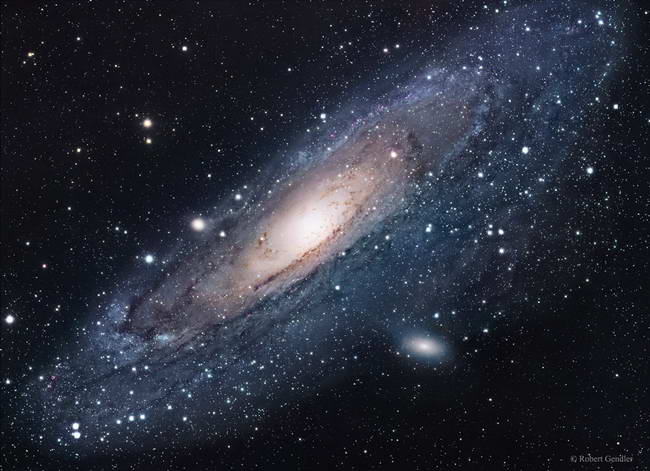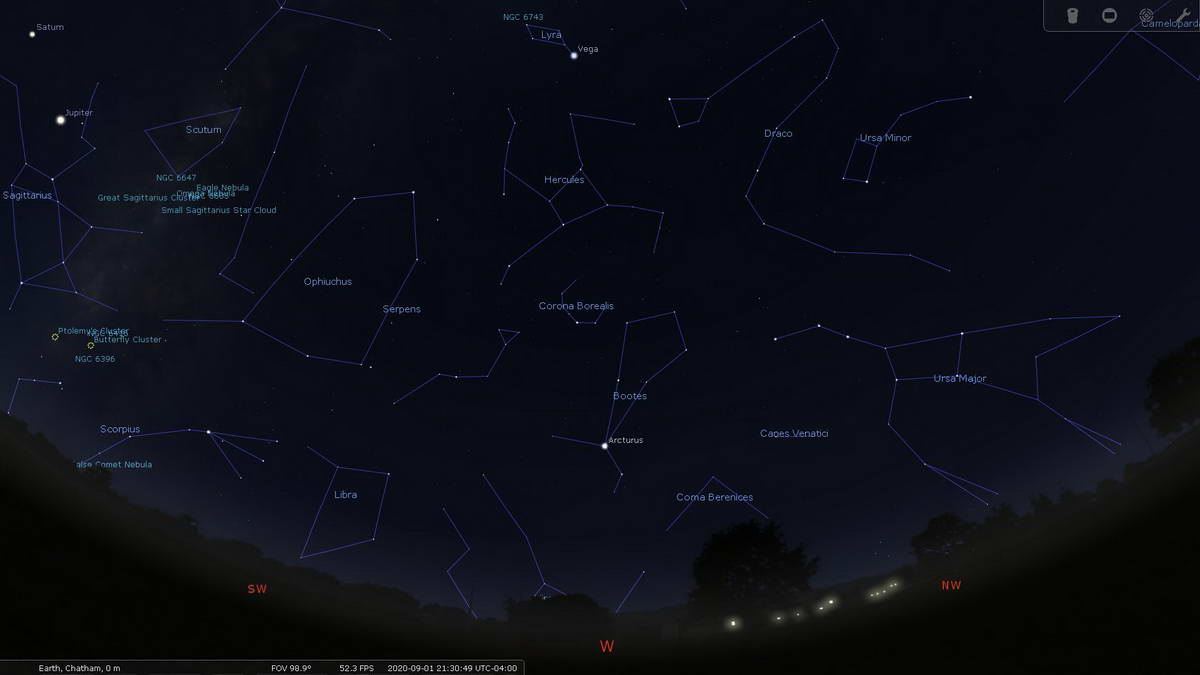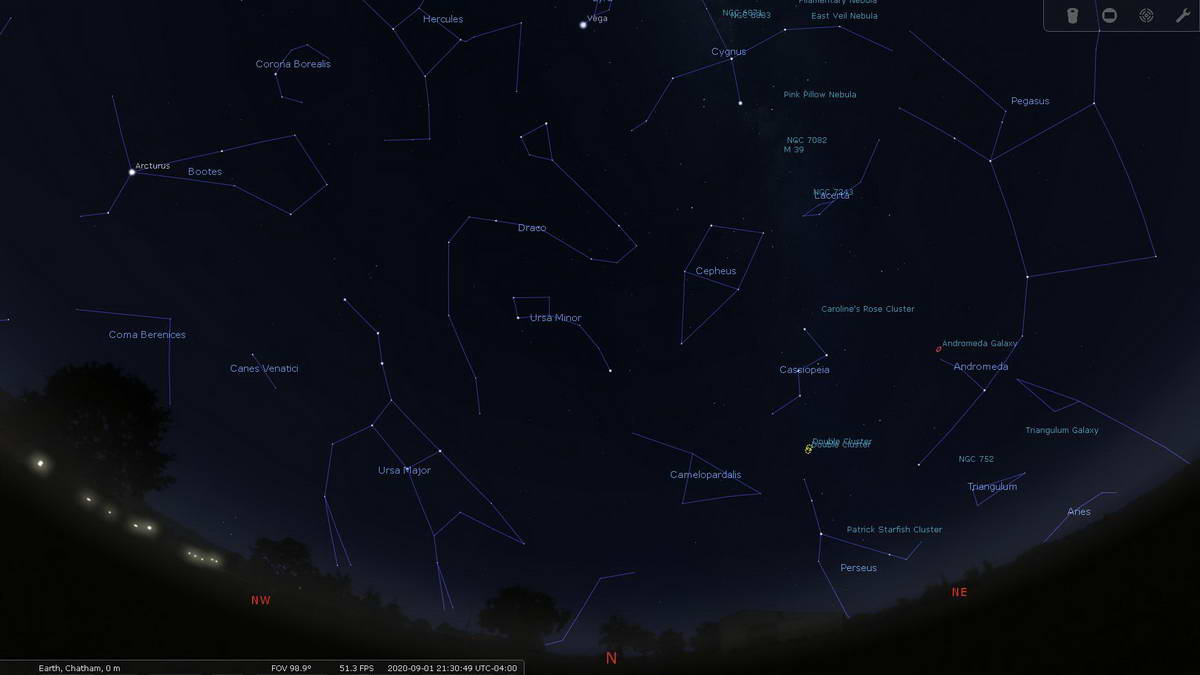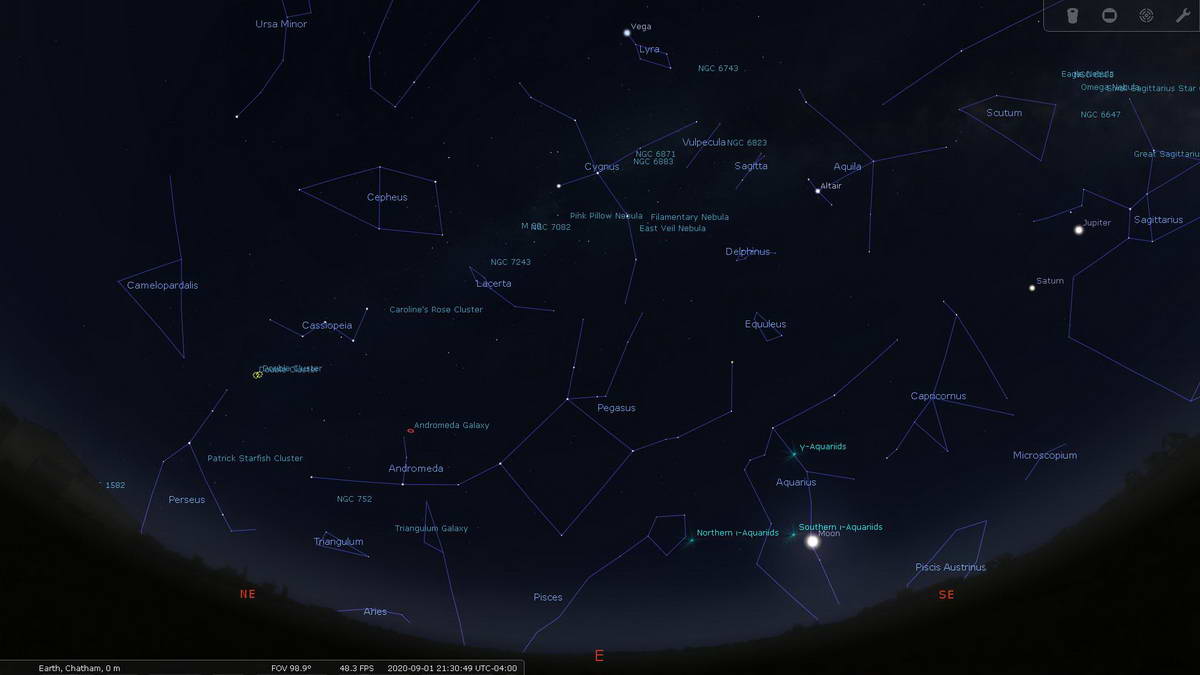The September 2020 Sky
September is a month of transition. Nights become longer and kids return to school. The month begins warm and summerlike but ends with a strong suggestion of autumn in the air. At the start, the grand vista of the Milky Way is visible arcing across the early evening sky, but the vast central region is beginning to slip below the horizon earlier and earlier. The Earth, in its orbit, is beginning to turn our attention away from the dense core of our galaxy and toward the wispy outer arms, and the intergalactic void.
In the early part of the month, approximately 45 minutes after sunset, Saturn and Jupiter can be seen riding just east of Saggitarius in the southern sky. The rings of Saturn are plainly visible through a modest telescope as we look “down” on the planet’s northern hemisphere from Earth. Jupiter, too, is always a great telescopic target, as its four largest moons are visible in binoculars. These two planets are bright enough to appear before the sky fully darkens and will slide westward, setting around 1:30 in the morning. As the month progresses, their time above the horizon will become shorter.
This is the month to take one last look into the heart of our galaxy. The rich star fields, clusters, and nebulae pay tribute to an amazing amount of energy and matter which is held in a cosmic dance by the central black hole(s) at the centre. It is an enjoyable experience on a warm night to lie on the ground with a set of good binoculars. Scanning the edge-on disk of the Milky Way provides perspective on just how small of an imprint humanity leaves. It is truly humbling and beautiful.
Turning to the west there are no planets visible in the early evening as the bright star Arcturus is preparing to slip below the horizon. Looking higher in the sky brings the constellation of Hercules into view. This area of sky contains M13, also known as The Great Cluster. One of the brightest globular clusters, it is a dense ball composed of hundreds of thousands of stars. This cluster orbits the central core of our galaxy along with others, forming a halo. M13 can be seen on a dark night with the naked eye. An easy binocular target, the cluster really shows its beauty through telescopes of progressively larger sizes as individual stars can then be seen.
Looking north, The Big Dipper is in the middle of its downward slide in the northwest. At mid-northern latitudes, it will not set. Instead, this group of stars will skim along the treetops of the northern horizon througout the course of the night. Also, in this direction, the view from Earth looks outside of our galaxy, into the emptiness beyond. All of the visible stars are part of the Milky Way. To see anything more in this direction takes the aid of a telescope.
M51, The Whirlpool Galaxy, is a fun target. It can be seen with smaller scopes, but a telescope of 8 inches or greater begins to bring out its detail. From Earth, it appears face on, displaying a pinwheel structure which is the classic look of spiral galaxies. Located just off the “end” of the Dipper’s handle, it is best to catch this one earlier in the evening as it becomes a much more difficult target as it skims the horizon later in the night.
A telescope of 8 inches in diameter and a dark sky may provide the right combination to reveal the small satellite galaxy that it is interacting with M51. The right equipment and conditions also offer the opportunity to hunt for two other deep sky targets in the general area which require a similar size scope. M81 and M82, also known as Bode’s Galaxy and the Cigar Galaxy, are located on the other end of Ursa Major (the constellation of which The Big Dipper is a part). These provide more of a challenge but also a great feeling of accomplishment when finally found.
In the east, the outer reaches of one of the Milky Way’s spiral arms arcs from overhead down to the northeastern horizon. Looking east or north of this glow is essentially looking “over” or “under” to see what is beyond. The crown jewel of the “beyond” in the Northern Hemisphere is riding about halfway up from the eastern horizon in the early evening. Located in the constellation of Andromeda, the Andromeda Galaxy (M31) is one of our nearest neighbors, contains billions of stars, and can be seen as a faint smudge in the sky with the naked eye. Binoculars and telescopes will improve the view markedly. M31 is awe-inspiring to see with the naked eye knowing that in that tiny grey smudge lies billions of stars, just like our galaxy.
Mars is not quite above the horizon yet but will rise around 10:30 local time and completes the September 2020 planets that are visible in the early evening. Mars is well worth a look through a telescope this fall. Earth and Mars are on their way to another close approach in the endless dance their orbits. As the distance between Mars and Earth decreases, Mars will grow in brightness in the sky, and also in size in the telescope. On a night with a steady atmosphere, the planet will potentially show its ice caps, clouds, and planetary features which appear as light and dark shapes on the disk. This is the time to take a look at Mars, as it will be another two years before the view is this good again.
Mention must be given to Venus which blazes brightly in the predawn hours. Except for the Sun and the Moon, it is the brightest natural light in the sky. This month starts with the nearly full Moon rising at sunset and continuing to make its appearances in the sky later and later into the night. By mid-month, the Moon is “new” and begins its appearance in our evening skies. Unfortunately, there are no major meteor showers this month to provide additional celestial fireworks.
Additional Resources for September 2020
Starmaps courtesy of Stellarium for PC / Deep Sky images courtesy of NASA
Published on August 25, 2020 / Information provided based on approximately 40 degrees north Lattitude














0 Comments